40 Must-Know Contract Management Trends for 2025
The data is clear, Contract management is undergoing a major transformation, with businesses shifting away from slow, manual processes toward more efficient, technology-driven solutions. In this post, you’ll discover the key stats and trends shaping the future of contract management, from the growing adoption of AI to the hidden costs of inefficiencies. You’ll see how companies are already cutting contract cycle times, improving accuracy, and reducing value erosion—and more importantly, how you can do the same. If you want to stay ahead in an increasingly competitive and digital business landscape, this is what you need to know.
- Automation & AI in Contract Management
- The Impact of AI and Automation on Efficiency
- Legal Workloads and the Need for AI & Technology
- Contract Complexity and Lifecycle Trends
- Contract Value Erosion & Cost Considerations
- Adoption of CLM and Contract Management Technologies
- The Future of Contract Management
- Resources:

Automation & AI in Contract Management
AI is taking the contract management world by storm, with rapid adoption and significant market growth on the horizon.
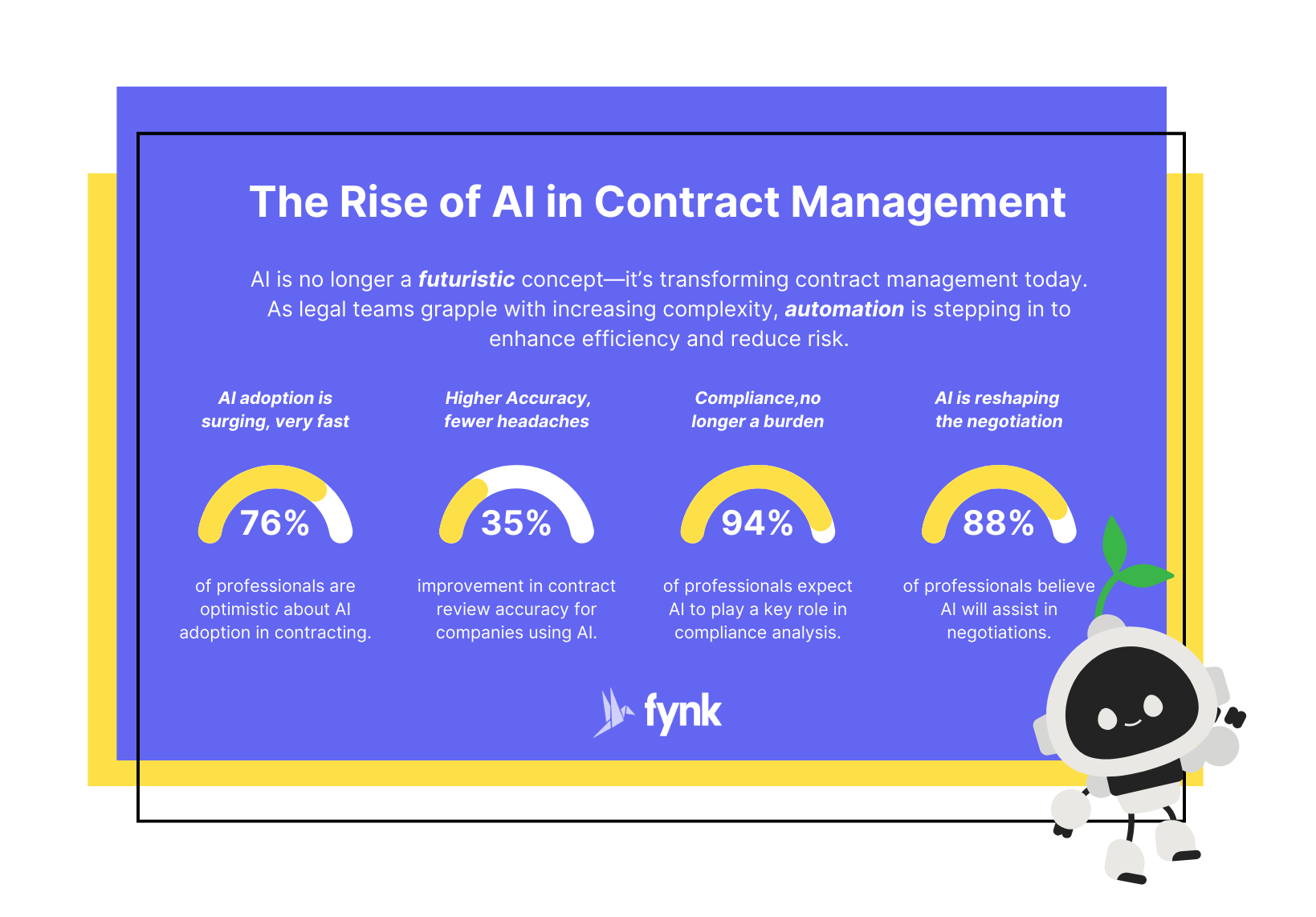


The Rise of Al in Contract Management
As legal workloads grow and processes become more complex, AI is emerging as a powerful tool to boost efficiency, reduce risks, and help you make smarter decisions.
Enthusiasm for AI is growing—76% of professionals were optimistic about AI adoption in contracting in January 2024, up from just 26% in June 2023. ^1
AI is not just about speed—it’s improving accuracy too. Companies using AI have seen a 35% improvement in contract review accuracy, reducing errors and ensuring contracts are more reliable. ^1
As contract complexity grows, risk management is becoming a top priority. 29% of businesses report that AI has enhanced their risk management and compliance efforts, helping them identify issues before they escalate. ^1
The potential applications of AI in contracting are vast. 94% of professionals expect AI to play a key role in risk and compliance analysis, ensuring contracts meet regulatory and internal requirements. ^1
Beyond compliance, AI is expected to reshape how contracts are created and negotiated. 88% of professionals believe AI will assist in negotiations, while 87% anticipate AI-generated contracts becoming the norm. ^1
With AI adoption rising, industries are moving at different paces. Technology, software, and legal sectors are leading the way, while healthcare and telecommunications are still developing their AI policies. ^1
AI’s ability to summarize and analyze contracts is highly valued. Professionals highlight contract summarization, analytics, and insights as the most desired AI capabilities, followed by automated drafting and risk monitoring. ^1
What you should do: Don’t wait to implement AI in your contract processes. Integrating AI into your contract workflow is easy. Start small by automating routine tasks like review and risk analysis using AI contract playbooks, then scale up to more advanced AI-driven workflows.
The Impact of AI and Automation on Efficiency
AI isn’t just improving contract management—it’s redefining it, turning slow, manual processes into seamless, high-speed workflows that get deals done faster than ever.
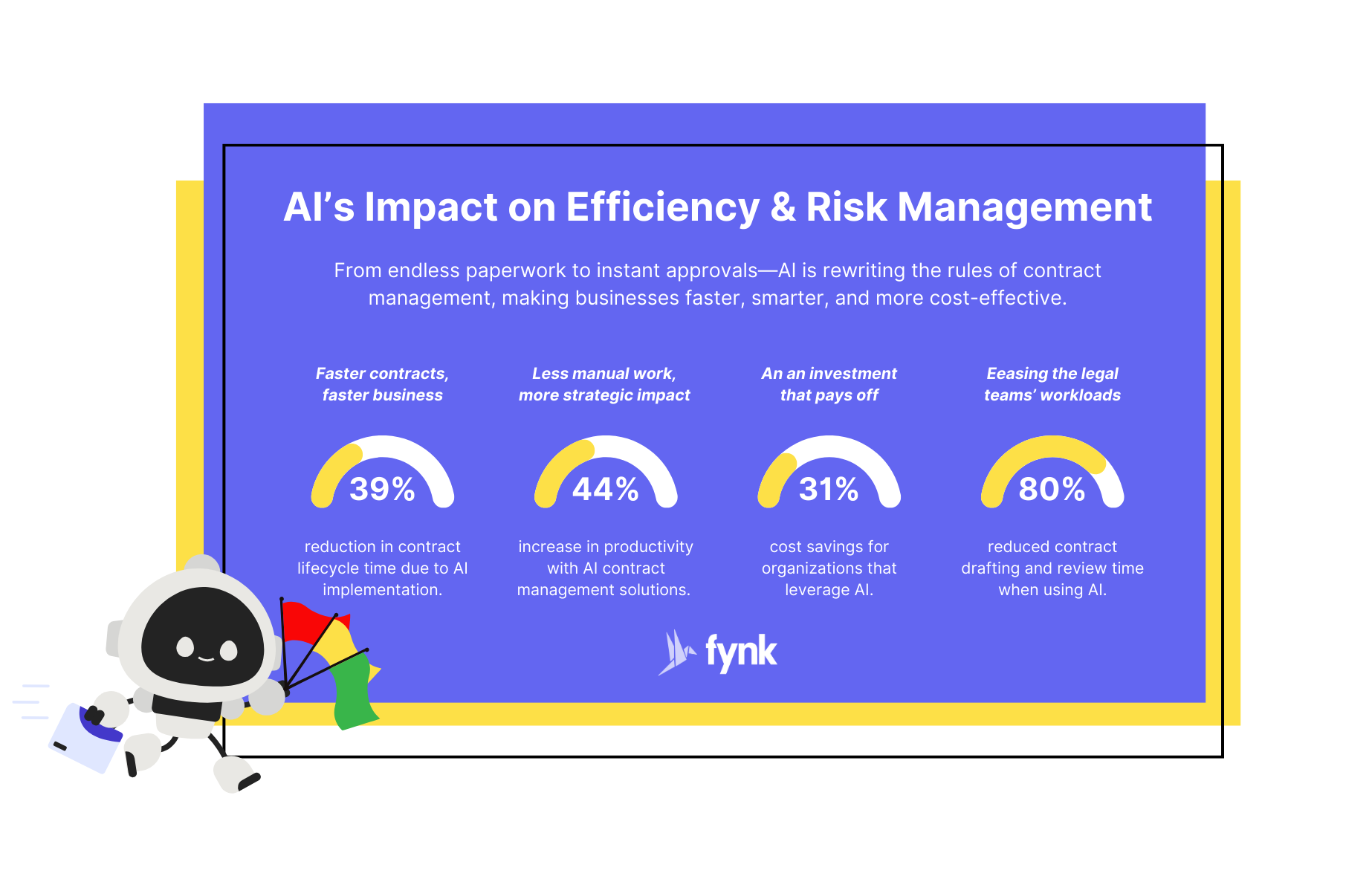


The Impact of AI and Automation on Efficiency and Risk Management
If you’ve ever felt bogged down by manual contract processes, AI is here to change that. The ability to move faster while maintaining precision isn’t just a competitive advantage—it’s becoming a necessity.
AI implementation has led to a 39% reduction in contract lifecycle time, streamlining everything from drafting to approval. ^1
Beyond accuracy, AI-powered contract management solutions have increased productivity by 44%, freeing teams from time-consuming manual tasks. ^1
Efficiency gains translate directly into financial benefits. Organizations leveraging AI in contract management have achieved 31% cost savings, proving that automation delivers tangible ROI. ^1
The impact of automation extends to compliance and risk management. 29% of companies report that AI has enhanced their ability to manage risks, helping them catch potential issues early. ^1
AI’s ability to automate contract workflows is being recognized across industries. Forrester Research states that CLM solutions can reduce contract drafting and review time by up to 80%, significantly easing legal workloads. ^2
AI also improves decision-making. More than 50% of legal departments plan to use analytics to enhance contract processes, allowing for smarter, data-driven improvements. ^2
The automation trend isn’t slowing down anytime soon—AI-driven automation is expected to be implemented in 75% of organizations for business-critical operations by 2025, making contract automation a standard business practice. ^3
What you should do: Use AI to cut contract lifecycle times, improve accuracy, and reduce costs. Automate repetitive tasks like approvals and compliance checks to free up time for more strategic work. The faster and more precise your contract management, the greater your competitive edge.
Legal Workloads and the Need for AI & Technology
The legal team is under more pressure than ever, balancing growing workloads with the demand for faster, more strategic results. But they don’t have to do it all manually.
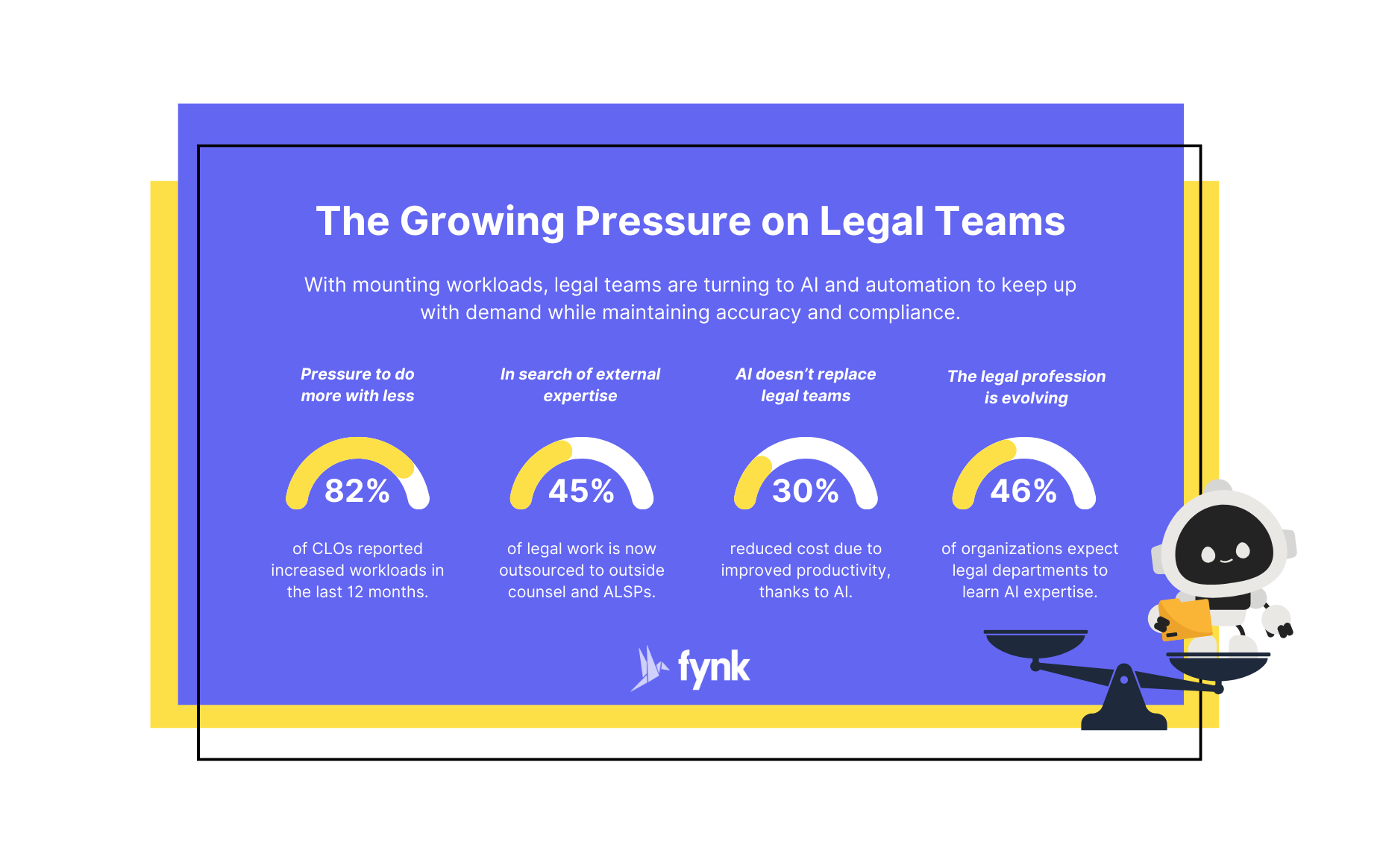


The Growing Pressure on Legal Teams
AI and legal automation are stepping in to handle routine tasks, optimize workflows, and support your most complex legal functions. By embracing technology, you can ensure your team spends less time on administrative burdens and more time making high-impact decisions.
82% of CLOs reported increased workloads in the last 12 months, highlighting the growing strain on legal departments. ^4
As workloads rise, legal teams are turning to external resources—45% of legal work is now outsourced to outside counsel and ALSPs, reducing the burden on in-house teams. ^4
The pressure to do more with less is driving the adoption of legal technology. 85% of CLOs predict increased use of technology in legal functions over the next 12 months. ^4
AI is emerging as a crucial tool to support legal teams. 88% of legal professionals believe AI will assist in redlining and contract negotiations, allowing for data-driven contract creation and analysis. ^1
The efficiency gains are significant—Generative AI could reduce legal department costs by 20-30%, with savings coming from improved productivity and reduced reliance on external counsel. ^5
Despite the growing reliance on AI, legal departments won’t shrink—they will evolve. 46% of organizations expect legal departments to remain the same size but with new skill sets, including AI expertise. ^5
What you should do: Lighten your legal team’s workload by leveraging AI-powered tools like fynk to automate your entire workflow. Shift routine tasks like contract drafting and risk monitoring to technology-driven solutions so your team can focus on high-value negotiations and strategy.
Sign
any
Document in Less than
a Minute.

Contract Complexity and Lifecycle Trends
Managing contracts isn’t getting any simpler, and delays can be costly. Depending on complexity, industry, and jurisdiction, contract timelines vary widely—but one thing is clear: slow-moving contracts create bottlenecks that hurt your business.
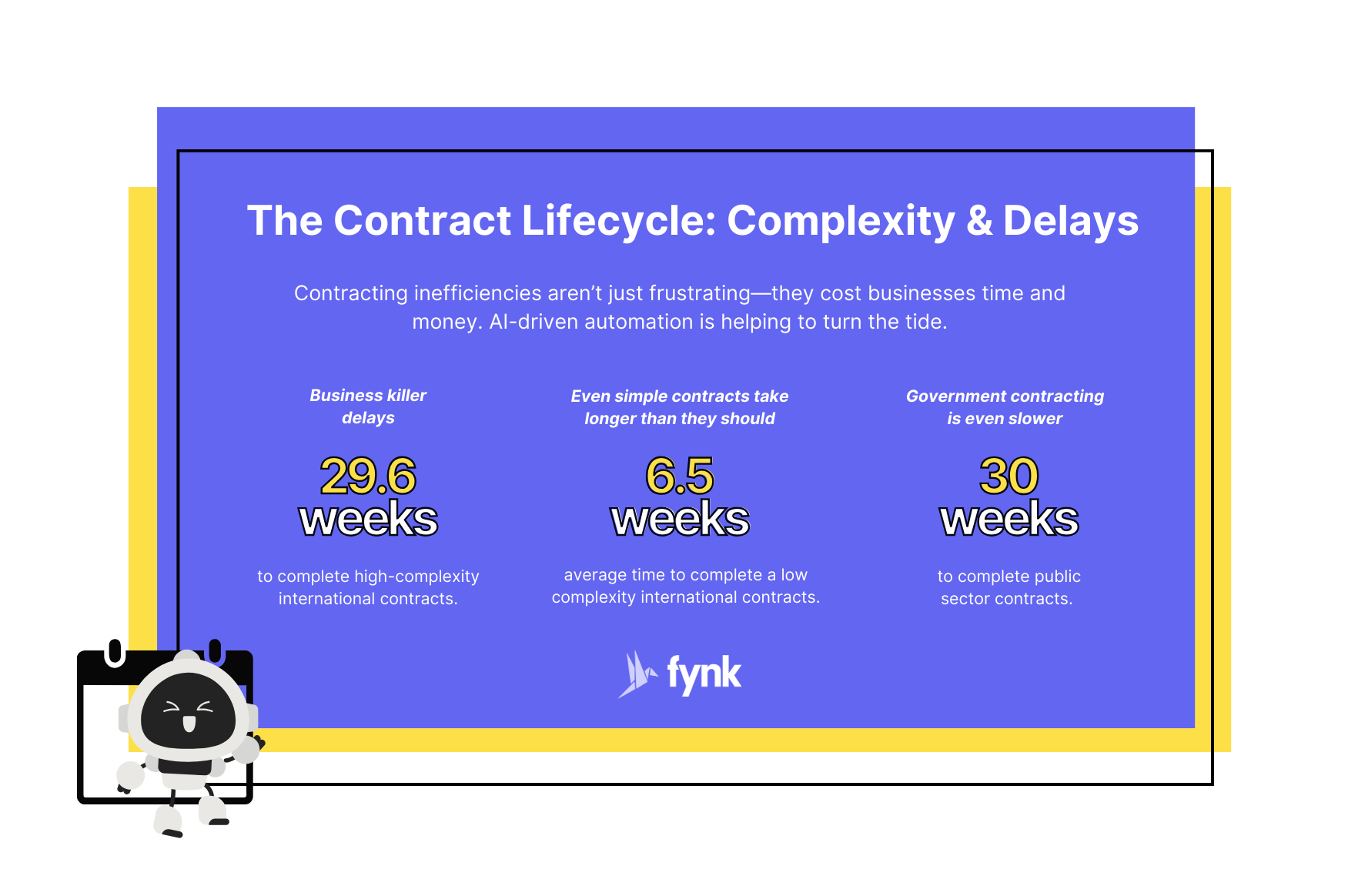


The Contract Lifecycle: Complexity & Delays
High-complexity international contracts take an average of 29.6 weeks to complete, showing just how lengthy and resource-intensive contract management can be. ^6
Even lower-complexity contracts aren’t as quick as they should be—domestic contracts with low complexity take an average of 4.4 weeks, while international contracts of the same complexity take 6.5 weeks. ^6
The public sector faces even greater delays. Low-complexity public sector contracts take 8 weeks, compared to just 4 weeks in the private sector, while high-complexity contracts take 30 weeks in the public sector versus 24 weeks in private organizations. ^7
Contracting inefficiencies aren’t just about time—they cost money too. More than 40 friction points in the contracting lifecycle create opportunities for value erosion or financial losses. ^8
To reduce delays and increase efficiency, many organizations are turning to AI. Contract automation is expected to reduce human intervention in contracting by up to 60% over the next five years. ^9
What you should do: Implement automation where possible for the entire lifecycle, especially in steps where you face the most delays. Ensure your processes are structured to handle complex negotiations efficiently.
Contract Value Erosion & Cost Considerations
Poor contract management is costing businesses millions, driving a surge in technology adoption to prevent value erosion and maximize financial returns.
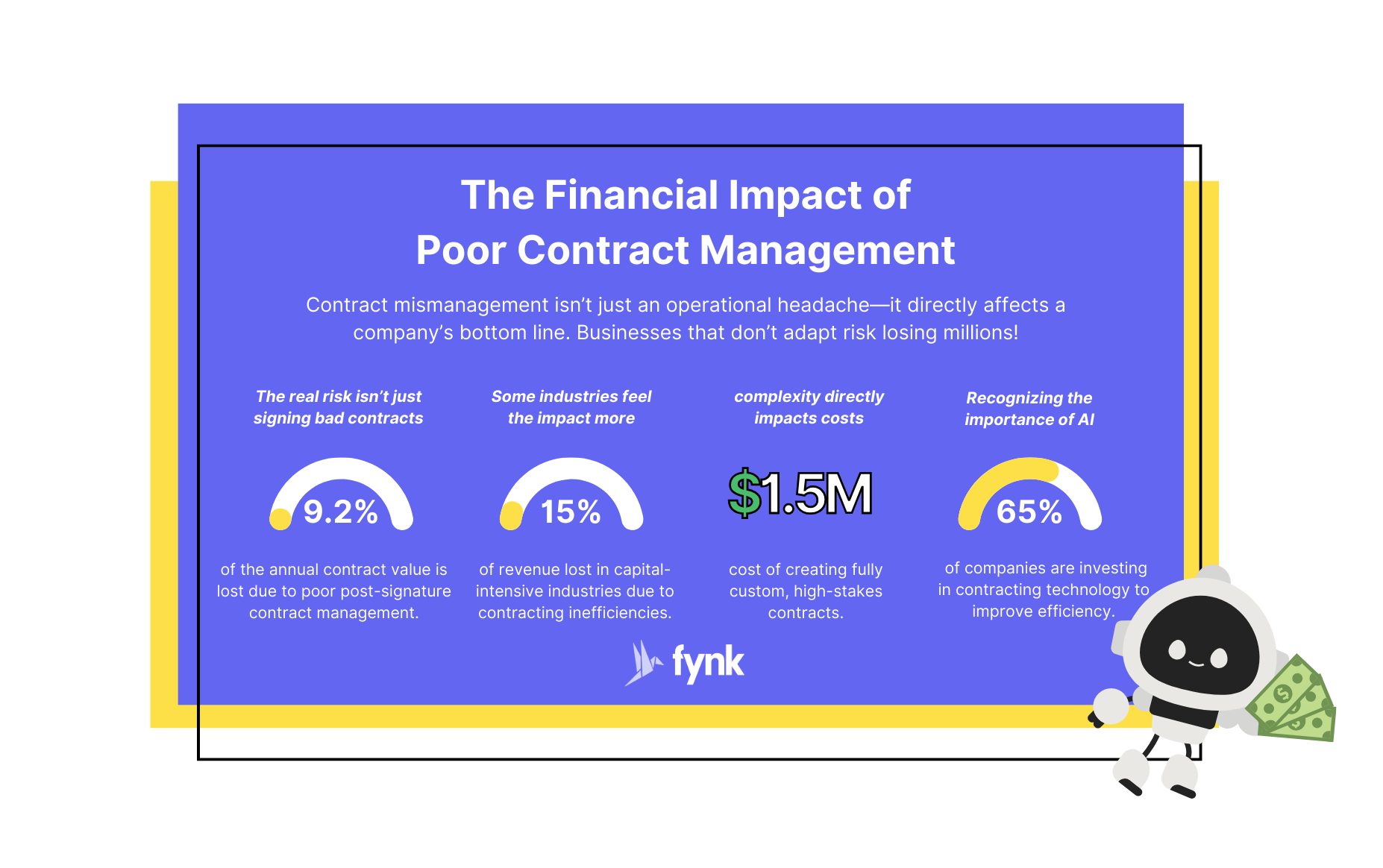


The Contract Lifecycle: Complexity & Delays
Whether it’s value erosion, hidden costs, or sluggish approvals, contract mismanagement can take a serious toll on your bottom line. If you want to maximize the financial impact of your contracts, improving visibility, reducing friction, and addressing inefficiencies should be at the top of your list.
9.2% of the annual contract value is lost due to poor contract management, with most losses occurring in the post-signature phase. ^10
Value erosion is improving, but slowly—the average contract value erosion stands at 8.6% in 2023, down from 10.9% in 2020. ^11
These inefficiencies come at a high cost—contracts cost organizations more than 8% of their annual revenue when factoring in production, management, and value erosion due to disputes. ^12
Some industries feel the financial impact more than others—contracting inefficiencies cost organizations 2-4% of revenue in consumer goods sectors and more than 15% in capital-intensive industries like construction and aerospace. ^8
The cost of developing a contract varies widely based on complexity—a simple contract using a standard template costs $0.05-$0.1M, while fully custom, high-stakes contracts can exceed $1.5M. ^8
One of the biggest contributors to value erosion is friction in the contracting process—more than 40 inefficiencies create opportunities for contract value to diminish before, during, and after execution. ^8
Organizations that take a proactive approach to contract management can minimize these losses. 65% of companies are now investing in contracting technology to improve efficiency, reduce risk, and enhance financial outcomes. ^8
What you should do: Reduce contract value erosion by improving oversight and tracking key performance metrics. Create legal playbooks for your most frequently used types of contracts and apply them using AI to reduce human errors for both pre and post-signature risks as much as possible.
Adoption of CLM and Contract Management Technologies
If you’re still managing contracts manually or with outdated tools, you’re falling behind. More organizations are investing in Contract Lifecycle Management (CLM) technology to automate processes, improve compliance, and enhance efficiency.
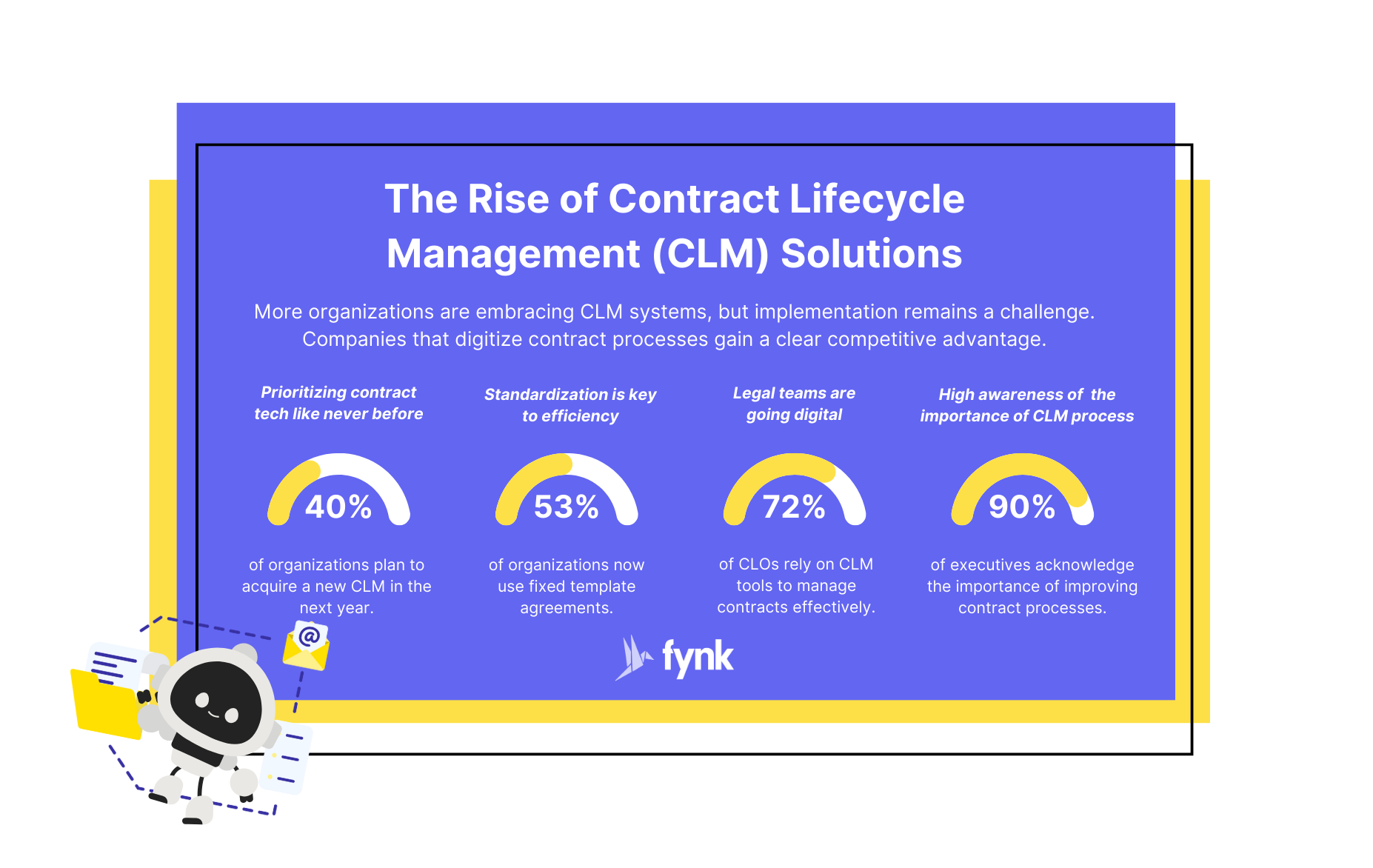


The Rise of Contract Lifecycle Management (CLM) Solutions
But while adoption is growing, many companies still struggle with full implementation. The right CLM system can help you take control of your contracts, reduce risk, and ensure that no key detail slips through the cracks.
40% of organizations plan to acquire a new contract management system in the next 12 months, signaling a strong shift toward digital transformation. ^11
Adoption of standardized contract processes is on the rise—53% of organizations now use fixed template agreements, a 29% increase from 2021. ^11
Legal technology is becoming a priority for corporate leaders—72% of CLOs now use legal hold systems, and 68% rely on CLM tools to manage contracts more effectively. ^4
Despite widespread recognition of the need for better contract management, progress is slow—more than 90% of executives acknowledge the importance of improving contract processes, but many still struggle with implementation. ^11
What you should do: Invest in a CLM system that automates workflows, ensures compliance, and improves contract visibility. Overcome adoption barriers by securing stakeholder buy-in and demonstrating the efficiency and cost-saving benefits of digital contract management.
🧠 Did you know? fynk is an AI-powered all-in-one contract management solution with a wide range of features and tools like
- E-signatures,
- AI legal playbooks,
- AI-assisted drafting,
- Centralized repository,
- AI review and analysis,
- Smart contract summarization,
- Automated reminders & notifications
- Automated and customizable approval workflows,
and many more!
fynk is designed to make contracts simpler and your life easier, even if you are not a legal professional. Give it a free try!
Searching for a contract management solution?
Find out how fynk can help you close deals faster and simplify your eSigning process – request a demo to see it in action.
The Future of Contract Management
The way you manage contracts today will look completely different in just a few years. AI, automation, and standardization are reshaping contract management, making processes faster, smarter, and more efficient.
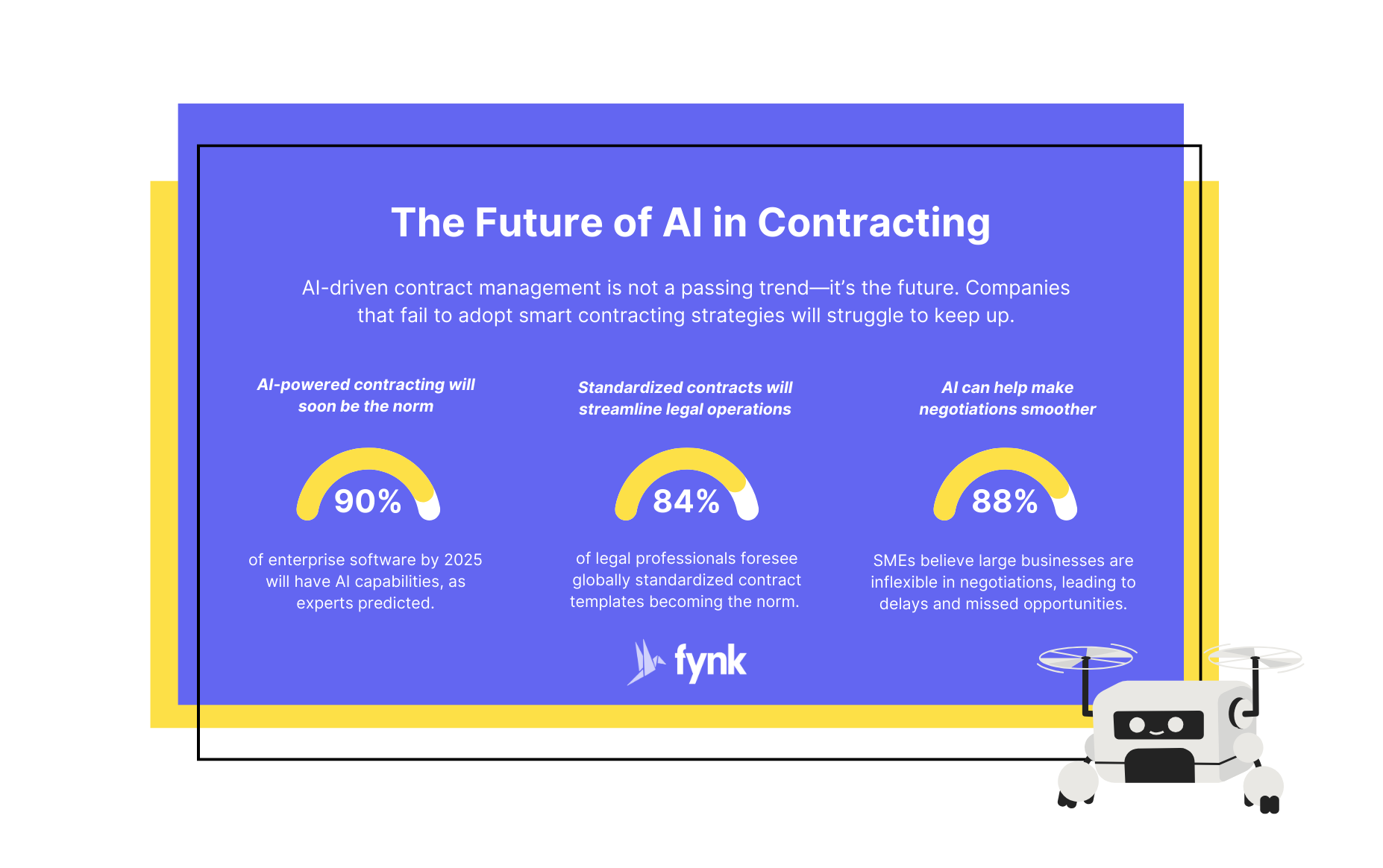


Early sidebar screenshot of what later became known as “fynk”
AI-driven tools will help simplify negotiations, reduce disputes, and align legal and business objectives. As organizations evolve their contract strategies, embracing technology will be key to staying agile, reducing risk, and unlocking new opportunities. The question is—are you ready for what’s next?
AI is expected to be embedded in 90% of enterprise software by 2025, making contract automation a standard feature in business operations. ^5
The role of legal teams is shifting—84% of legal professionals foresee globally standardized contract templates becoming the norm. ^13
Contract negotiations are still a major pain point—88% of SMEs believe large businesses are inflexible in negotiations, often leading to delays and missed opportunities. ^14
AI will help simplify and accelerate negotiations—the most negotiated contract terms include limitation of liability, price adjustments, indemnification, and termination clauses. ^14
What you should do: Prepare for a fully digital, AI-driven future by adopting smart contract strategies today. Standardize contract processes, integrate AI-powered automation, and leverage analytics to make data-driven decisions. The future is already unfolding—don’t get left behind.
Final Thoughts: Adapt Now or Fall Behind
Manual processes are on their way out, and if you don’t adapt, you risk falling behind. With AI set to be embedded in 90% of enterprise software by 2025, now is the time to embrace the shift. Whether you want to improve contract accuracy, speed up lifecycle times, or prevent value erosion, technology is already providing solutions to these long-standing challenges.
By taking action now, you can position yourself as an industry leader—operating faster, more efficiently, and with stronger risk management. The time for hesitation is over—the real question isn’t whether AI will transform contract management, but whether you’ll be ready for it.
Resources:
1.^ AI in contracting: untapped revolution to emerging evolution Insights from the global contracting community - WorldCC
2.^ AI-Driven Contract Management - Speed and Control CAN Co-exist - ULTRIA
3.^ Tech Trends 2025 - Deloitte Insights
4.^ The 2024 Chief Legal Officer Strategy Survey - Deloitte
5.^ The future of legal work? The use of Generative AI by legal departments - Deloitte Legal
6.^ 2023 Benchmark Study - WorldCC
7.^ CCM benchmark public sector insights - WorldCC
8.^ The ROI of contracting excellence - WorldCC
9.^ Contract and Commercial Management: Role and Direction - IACCM
10.^ The next frontier for contract management - Deloitte
11.^ CCM: The journey to operational excellence - WorldCC
12.^ The AI-Enabled Future of Commercial and Contract Management - WorldCC
13.^ Going beyond risk and compliance: Legal functions embracing digital - Deloitte
14.^ Most Negotiable Terms 2024 - Including exploration of the distinctions between big businesses and SMEs - WorldCC
Please keep in mind that none of the content on our blog should be considered legal advice. We understand the complexities and nuances of legal matters, and as much as we strive to ensure our information is accurate and useful, it cannot replace the personalized advice of a qualified legal professional.

Table of contents
- Automation & AI in Contract Management
- The Impact of AI and Automation on Efficiency
- Legal Workloads and the Need for AI & Technology
- Contract Complexity and Lifecycle Trends
- Contract Value Erosion & Cost Considerations
- Adoption of CLM and Contract Management Technologies
- The Future of Contract Management
- Resources:
Want product news and updates? Sign up for our newsletter.
Other posts in Business

40 Must-Know Contract Management Trends for 2025
The data is clear, Contract management is undergoing a major transformation, with businesses shifting away …
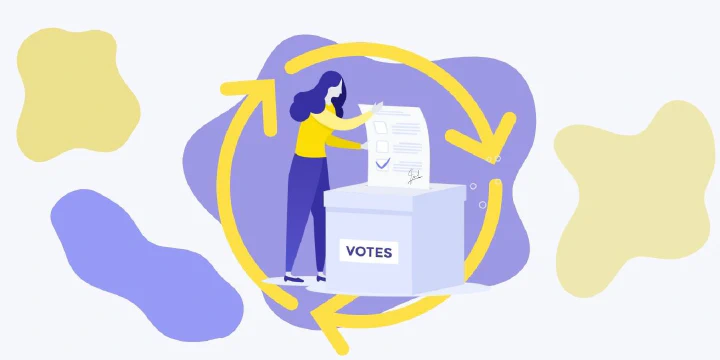
Guide to Circular Resolutions for Ltd. Shareholders + Templates
Shareholders are involved in decisions such as approving financial statements, electing or re-electing …

Contract Renewal vs. Contract Extension
Explore the distinctions between contract renewal and extension, including their advantages and drawbacks, …
Other posts in Contract-Management

SaaS contract management explained for buyers and vendors
If you work in SaaS, you know how quickly contracts can pile up. Each one comes with its own terms, renewals, …
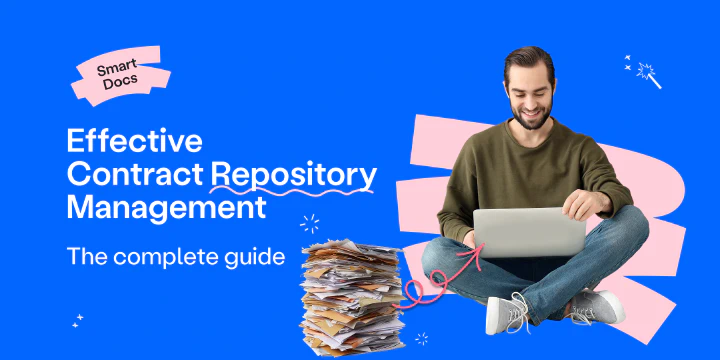
The Complete Guide to Effective Contract Repository Management
A contract repository is where every agreement your business depends on finally finds its place. No cluttered …
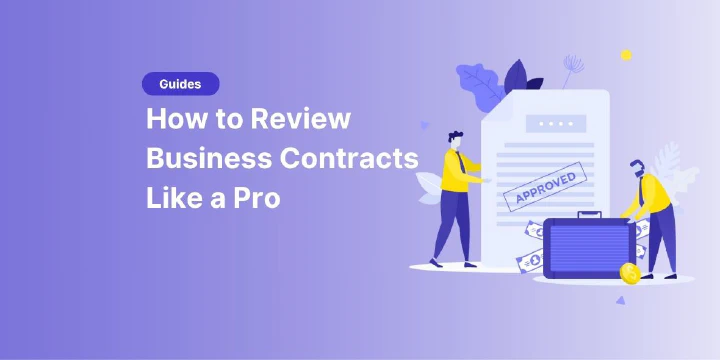
How to Review Business Contracts Like a Pro in 2025
When it comes to business contracts, what you don’t catch can hurt you. That’s why reviewing a business …
Contracts can be enjoyable. Get started with fynk today.
Companies using fynk's contract management software get work done faster than ever before. Ready to give valuable time back to your team?
Schedule demo

